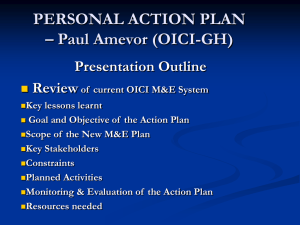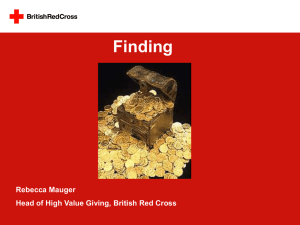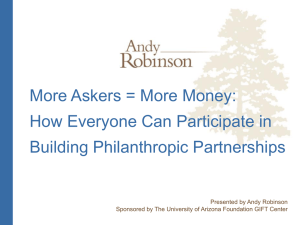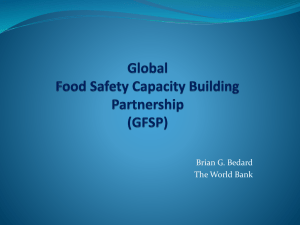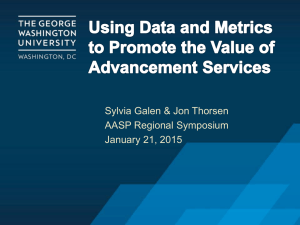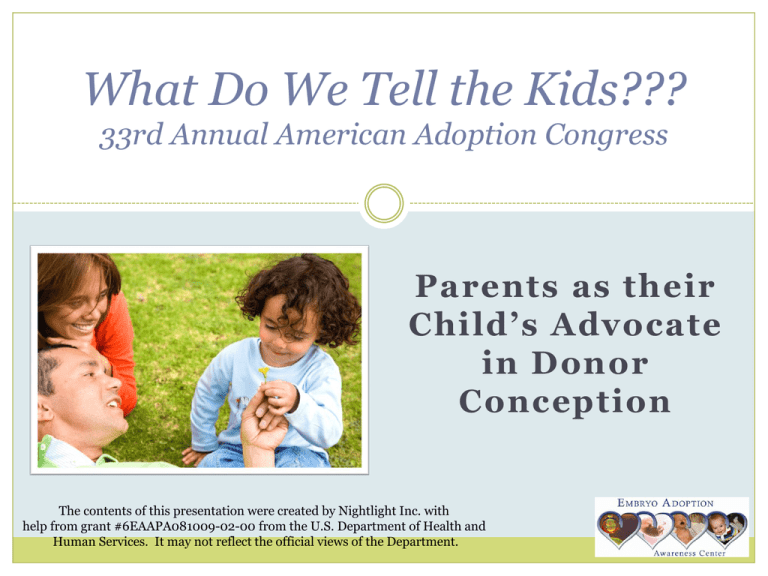
What Do We Tell the Kids???
33rd Annual American Adoption Congress
Parents as their
Child’s Advocate
in Donor
Conception
The contents of this presentation were created by Nightlight Inc. with
help from grant #6EAAPA081009-02-00 from the U.S. Department of Health and
Human Services. It may not reflect the official views of the Department.
Kris Probasco, LCSW, LSCSW
Adoption & Fertility Resources
cca144@sbcglobal.net
816-781-8550
Licensed in the states of Missouri and Kansas as social worker and
adoption agency.
She has practiced since 1972 in her specialty of adoption, infertility
and reproduction.
Partnered with three fertility medical practices in the Kansas City
area, specializing in work with families formed by a donor conception.
Kris provides placement services for domestic, international, and
embryo adoptions, which include counseling for prospective birth and
genetic families.
Consults with agencies interested in partnership model.
AND DONOR CONCEPTION SHOULD NOT, EITHER
The worst thing about
Being lied to is
Knowing you weren’t
Worth the truth
History of Donor Conceptions
1884 – First Documented Case of Donor Sperm Insemination, R. Snowden,
Artificial Reproduction, A Social Investigation, Artificial Reproduction; a Social
Investigation, 1983
1983 – First Documented Case of Egg Donation – UCLA Medical Center
1988 – The Office of Technology Assessment estimates that 30,000 U.S. children
were born via donor insemination during 1986-87
1997 – First Case of Embryo Placement and Adoption- Snowflakes, Nightlight
Adoption, Inc.
Approximately 60,000 Children Born by Donor Conceptions each year in the
United States. However, in the U.S. there is no accurate tracking or record keeping,
so it is likely there are many more donor conceptions.
612,000 Frozen Embryos awaiting decisions about their outcome, 2011 California
State Fulton Research
Annually there are approximately 25,000 to 30,000 traditional adoptions and
9,341 (2011) international adoptions.
Telling the Kids:
The 4 Stages
Parent Preparation
The Younger Years [Birth-6]
The Middle Years [7-12]
The Adolescent Years [13+]
Early Honesty
Leads to Trust
Children often “sense” there is a secret; they
sense there is “something wrong.”
Secrets almost never stay secret forever. It is
far easier to share with a three-year old than a
twenty-three year old.
When secret information finally comes out, the
feeling of betrayal can be overwhelming.
Secrets in families
are damaging.
Parents can demonstrate ‘honesty’ and
‘integrity by being honest with their child about
their beginning story from an early age
Speaking about their beginning story casually,
early and often makes it simply a part of their
family. It’s their normal
Early Honesty
Leads to Trust
Parents can begin
talking to their children
about their conception
the minute the child
enters their lives or
before.
Younger Years [Birth-6]
Grieving the loss of the genetic child
Parent
Preparation
Next best choice in bringing a child into the family
Accepting differences
Adoption research
states that who we
become is
approximately 50%
nature and 50%
nurture.
Accepting the significance of the genetic
component
Accepting the child’s life-long genetic, social and
emotional connections to their biological family
Learning as much as they can about the genetic
family
Openness in the process will provide life-long benefits for
the child.
Sperm Bank of California – first sperm bank with open
identified donors – offspring want adult picture, social
information and how many half siblings
Parent Preparation
•Provides a resource
medically
•Offers the children
greater
understanding of
their story
•Understanding of
needs of children born
through donor
conception
•Gain support
•Foster openness
•Secrecy causes
difficulty
Begin to practice
talking to your
child during
infancy with
positive language
and feelings:
“We were meant to be
your parents. We are so
happy that we got help.
We have so much to tell
you. We are excited for
you to understand your
story.”
Younger Years [Birth-6]
Children’s
Curiosity
All children are
curious as to how
they came to be.
Children start asking
questions about babies
and pregnancy around
age 3.
Parents can use these questions as a
jumping off point for explaining their
child’s donor story.
Be honest without going into details
that will be beyond a young child’s
ability to comprehend
Let the child’s questions lead the
discussion.
Answer the questions with a tone of
celebration and awe at the amazing
way they joined your family
Celebrating
their Story
Celebrate their unique arrival.
Foster a positive attitude about their conception, birth
and family
The goal is for the
child to not
remember being told
because they always
knew how they came
into the family.
The donor conception decision as the beginning of a
positive story
The Goal: Share all that is known about the donor
family and their journey
The attachment process is enhanced by honest
stories
Telling about Technological Conception
Need to be prepared to
explain to the child the
complex nature of
technological
conception in simple,
age appropriate terms.
Start talking about their
conception story when
they are preverbal to
help yourself become
comfortable with the
language.
Telling about Technological Conception
Use the words “sperm” and
“ova” when describing how
an embryo is formed.
Babies grow in a “uterus”.
Inaccurate words can
confuse the child
Choose terms that are
comfortable for your family to
describe the genetic/donor
family. Use accurate terms.
Terms may evolve as your child
matures
Children DO need to begin
processing that there are
other people in the word to
whom they are connected
in a significant and lasting
way
Younger Years [Birth-6]
Storybooks can be a useful tool to
introduce the story of conception.
XYandME.com
www.hopeandwill.com
Celebrating their Story
Their Beginning Book
Pictures of parents wanting a child
The couple’s decision making
Waiting for a positive pregnancy test
The clinic where the parents
received assistance
Celebrating their Story
The Life Book
The doctor’s office
The helper/donor that gave their
genetics for the child’s life
Pictures throughout the pregnancy
and birth
Pictures of the child coming home
Younger Years [Birth-6]
The message should be clear that we wanted to have
children.
We accepted and celebrate the assistance of many
people.
Look for opportunities to point out places where
events took place. Showing the child these places
provides images and concrete facts for the child.
Talk about how
there are many
ways that children
come into their
family.
Todd Parr has authored
many books about
families and the
importance of the love
they share with each
other.
Younger Years [Birth-6]
Why am I
different? Do
you love
me as
much as
you would
if I
came rom
pieces of
you and
Daddy?
Why did our
donor help to
give me to you?
Will you always
love me?
Middle Years [7-12]
The Middle
Years [7-12]
Questions arise at
the most unexpected
moments.
Go with the flow in
terms of questions.
Keep the
conversation
active:
Bring up the subject
from time to time.
The message:
We are comfortable
with this. It’s okay to
ask questions.
Girls tend to ask
questions earlier than
boys.
The Middle Years [7-12]
Between ages 7-10 is
generally when the “ahha” moments occur.
There will be a time of
grief, sadness and
disconnect for the child
Explain that many
families are not able to
make a baby and
needs lots of help to
bring children to their
home.
The groundwork laid
before will assist in
the child’s acceptance
Particulars about the child’s
story will be helpful. Their
story may include sperm or
egg donation or embryo
placement and adoption.
The Middle Years [7-12]
When asked “How are babies made?” share factual
information.
Sex education from family and school is starting to
make more sense.
The realization of who they are and their conception
story is not a shock because of the early telling.
Lots of questions will be asked and information
provided as the questions indicate.
The Middle Years [7-12]
• It is best to have most information provided
to the child as they reach adolescence.
• All extremes are possible from not wanting
to talk to talking about it frequently.
• Keep lines of communication open.
If they are asking
questions you do not
have the answer for, it is
best to have empathy for
the child by saying “I
would want to know,
too.”
If there an open donor
situation, the child can
write down questions
that can be asked of the
donor family the next
time there is
communication.
The Middle Years [7-12]
Who Am I?
Adolescent Years [13+]
Process Externally
• May show emotion, but
the facts of their
conception do not
dictate who they are
Sex education is
beginning to make
sense
Adolescent Years
Middle Years
Adolescent Years [13+]
Process Internally
• What they have been
told becomes theirs
• Anger and accusation
is normal
• Behavior reflects work
done in middle years
Learning about
science,
reproduction and
DNA
• Teens will identify the
scientific concepts with
themselves
Adolescent Years [13+]
Middle Years
Parents hold
ownership of child’s
genetic history
•Any communication with the
fertility facility, sperm bank,
or direct contact is managed
by the parents.
Adolescent Years
Child takes ownership
of genetic history
•Will they want contact with
the resources that assist in
their conceptions or with the
donors/half siblings
themselves. The Donor
Sibling Registry has 38,000
families registered.
Adolescent Years [13+]
•Understand their story
•Tell everything they know
•Find out how they are similar and
different from their families
•Understand the teenager’s quest
for identity without becoming
defensive
•Determine how they become a
unique individual
•Adolescents may challenge their
families
Adolescent Years [13+]
Teen’s Role
• Ask questions
• Form their identity
• Find ways to feel secure in who
they are becoming
• Take charge of who they tell
and the consequences that
follow
Parent’s
Responsibility
• Distinguish between the facts
of their conception from the
normal responsibilities of
parenting
• Attach, parent, and educate
• Find the fine line between
wanting the child to be proud
of who they are while helping
them maintain privacy
Parents being the
child’s advocate
presents many joys
and celebrations, as
well as many
challenges.
Embracing the Joys and Challenges
How Do Secrets Stop Being Secrets?
There will
Never be a
“Right
Time”
It’s very important to
share with your children
about their origins NOW
rather than LATER.
Put Together a Lifebook
and Share Truthfully
Get out the baby books,
the pictures, and all
mementos from your
journey to conceiving
your children…whether it
was through egg
donation, sperm
donation, or embryo
adoption.
Start off by telling your
children, ‘We really
wanted to have a baby
and we needed some
help.’
…Then tell the whole
story.
How Do Secrets Stop Being Secrets?
“Why didn’t you tell me earlier?”
Do not tell them:
We wanted to
protect you.
We didn’t know
how you’d react.
We didn’t want
you to feel
different from
other kids.
Focus on the
truth that you
wanted the child
to have the
information now,
because it is
important
information for
them to have.
You know they
are mature
enough to process
this information
and decide whom
to share it with.
It is a personal
family story and
they are old
enough to carry it
with them now.
They are not so
young that they
will be careless
with it. They have
the right to keep it
private or tell
those whom they
want to share it
with. It is their
story now, not
just their parents’
story.
How Do Secrets Stop Being Secrets?
Welcome the child’s
questions...any questions
any time
•Answer their questions
honesty
•If you need time to find the
best answer, tell them you
need to think about it for
awhile and will get back to
them. Keep your promise!
Bring up the donor
story from time to
time
•Make sure both
parents bring up
the story with their
child from time to
time.
The child may be sad
that they don’t share
genetics with you.
•Acknowledge their
sadness
•Tell them you were sad
about it too before they
were here. But now you
are so happy that they
are who they are.
•The child will be angry
about their genetic
history
•They will be angry if
they feel lied to and
betrayed
Resources from the Donor Conception Network
Telling and Talking about Donor Conception
by the Donor Conception Network (DCN)
Written by a parent of donor conceived
young people and based on children’s
developmental stages, these books provide
parents with a source of emotional support
and practical guidance in finding the right
time and language to tell and continue
conversations with their children over the
years.
Available At:
http://www.infertilitynetwork.org/dc_telling


